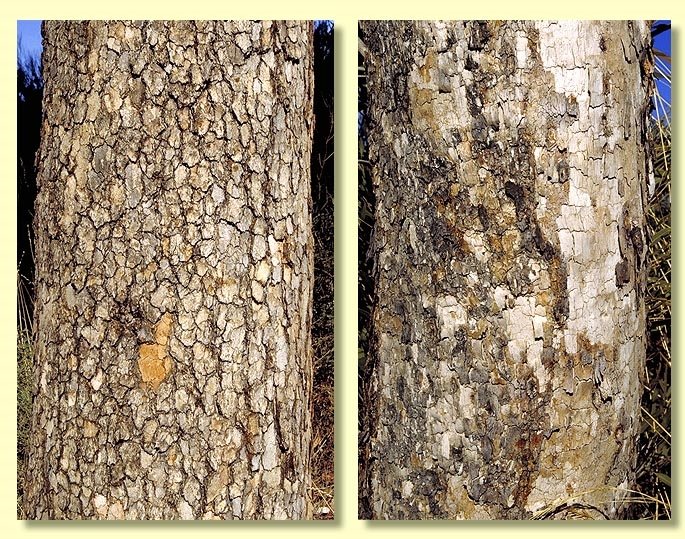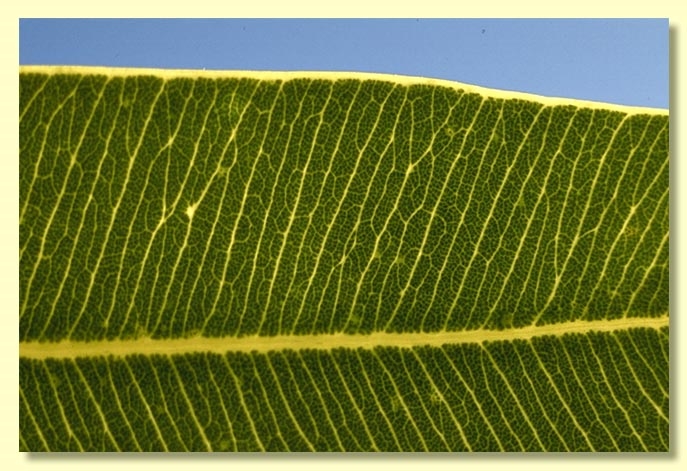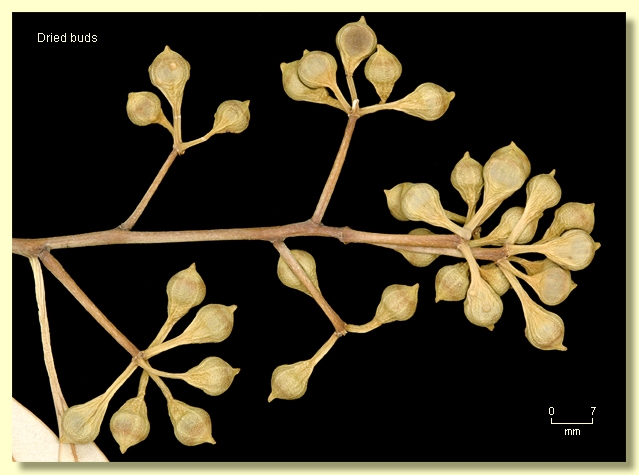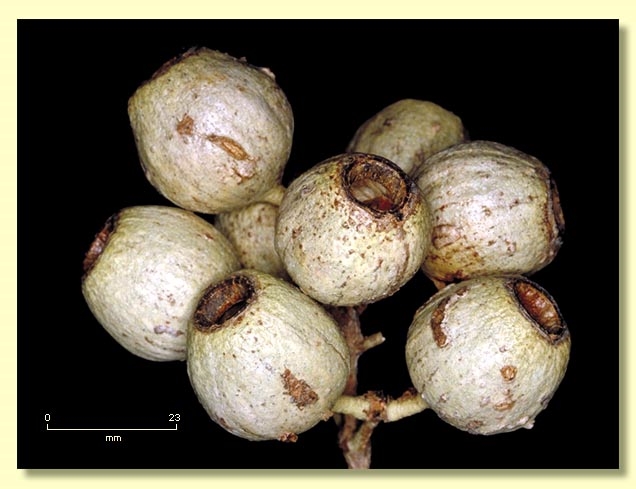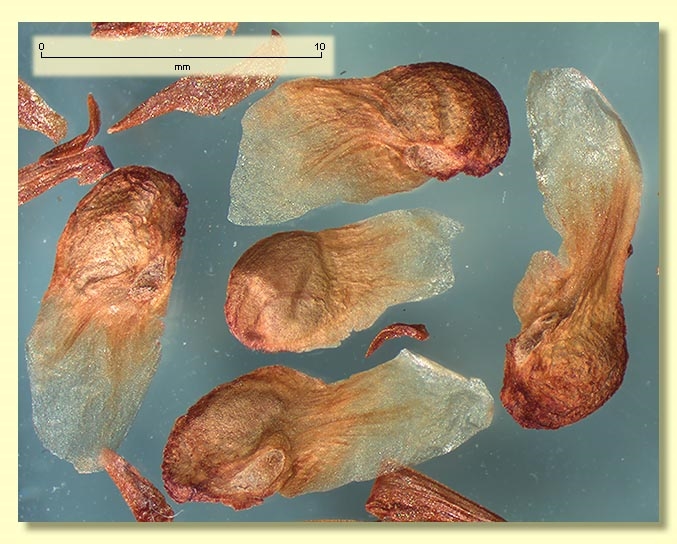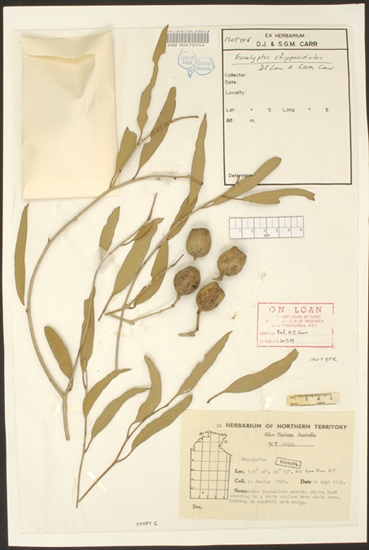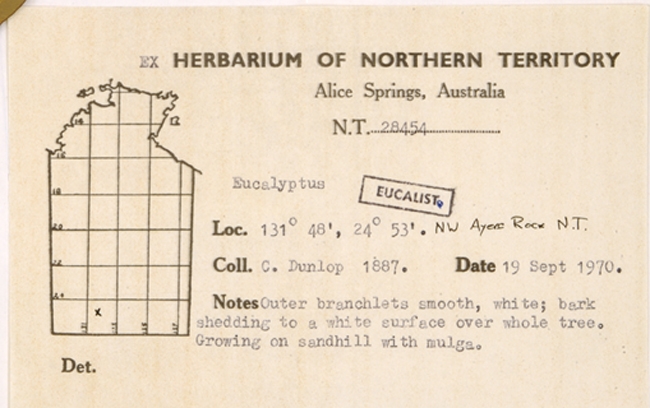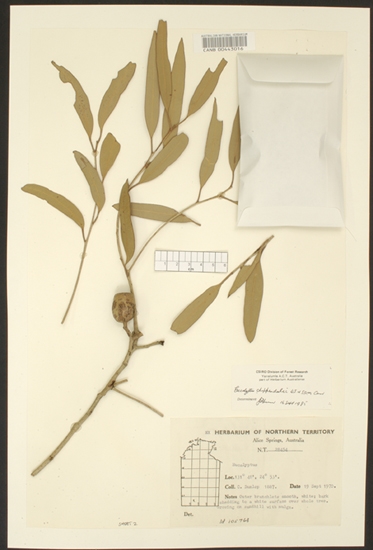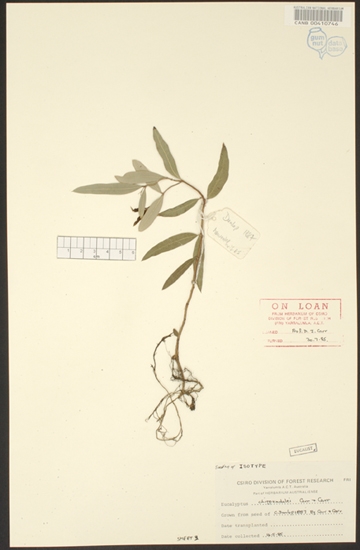Euclid - Online edition
Corymbia chippendalei
Corymbia | Rufaria
Bark usually rough and tessellated to the upper trunk, pale brown to cream, sometimes thin and flaky and present only on the lower trunk; smooth bark cream to white.
Branchlets lacking oil glands in the pith.
Juvenile growth (coppice or field seedlings to 50 cm): stems round in cross-section, sometimes scabrid on the lower stem; juvenile leaves petiolate, opposite to sub-opposite, narrowly lanceolate to lanceolate, 5–11 cm long, 1–2 cm wide, green.
Adult leaves alternate, petiole (0.7)1–2 (2.8) cm long; blade lanceolate, (6.5)8–13 cm long, 1–2.3 cm wide, flat, concolorous, glossy, green, base tapering to the petiole, margin entire, apex acute, side-veins penniveined, reticulation very dense, intramarginal vein absent, oil glands obscure or absent.
Inflorescence terminal compound, peduncles 0.5–2 cm long, buds 7 per umbel, pedicels 0.1–0.7 cm long. Mature buds obovoid to pyriform, 0.7–0.9 cm long, 0.5–0.7 cm wide, surface smooth (not scurfy), scar absent (both opercula shed together at flowering), operculum rounded to conical, stamens inflexed, anthers oblong, versatile, dorsifixed, dehiscing by longitudinal slits, style long and straight, stigma papillate (mop-like), locules commonly 3 (occasionally 4), ovules not in regular rows. Flowers white.
Fruit usually pedicellate (pedicels 0–0.5(1) cm long), truncate-globose, rarely urceolate or truncate-ovoid, 1.6–2.8 cm long, 1.5–2.5(2.7) cm wide, usually thick walled with a thickish rim, disc vertically descending, valves 3 (rarely 4), deeply enclosed.
Seeds brown, ellipsoidal with terminal wing, 9–13 mm long (including wing).
Cultivated seedlings (measured at node 10): cotyledons reniform to orbicular; stems round in cross-section, leaves petiolate, opposite to subopposite, narrowly lanceolate to lanceolate, 5–11 cm long, 1–2 cm wide, dull to slightly glossy green, base tapering to the petiole, lamina scabrid until ca the 5th node.
Flowering has been recorded in January.
A small tree or mallee of desert country in central-eastern Western Australia and central Australia, usually on sand dunes. Corymbia chippendalei usually has rough, tessellated bark over most of the trunk but the bark can be on occasion very thin. Adult leaves are concolorous, glossy, light green to yellow-green with no intramarginal vein, and the buds are smooth and the fruit are truncate-globose, lacking a neck.
C. chippendalei is found in deserts where the widespread desert or plains bloodwood C. terminalis (here including C. opaca and C. tumescens) also occurs, but the latter prefers flat country. C. terminalis differs by having scurfy buds, and fruit usually with a neck and a relatively thin rim (the orifice is thick-rimmed in C. chippendalei). Another bloodwood of the area preferring flat sandy deserts is C. lenziana. It differs from C. chippendalei in having a drooping habit with narrower leaves and smaller fruit.
Another bloodwood species restricted to these central areas is C. eremaea, found in the far north-west of South Australia and adjacent areas of Western Australia and central Australia, preferring to grow on the tops or upper slopes of rocky hills. C. eremaea has smooth buds like C. chippendalei but can be easily distinguished from that species by the smaller, urceolate fruit with a well developed neck. On harsh sites C. eremaea is commonly a mallee with little or no rough bark.
MORE ABOUT CORYMBIA
MORE ABOUT RED BLOODWOODS
Corymbia chippendalei : after George McCartney Chippendale (1921–2010).
George Chippendale began his botanical career in 1936 as an assistant at the National Herbarium of New South Wales. After war service (1941–1945) and graduating from the Sydney University (1946–48), he was promoted at the National Herbarium to the position of botanist, which he held between 1950 and 1954. From 1954 to 1966, he was the resident botanist for the Northern Territory Administration based at Alice Springs. During this period he collected extensively in the local area and developed a special knowledge of the vegetation of the dry inland. From 1966 until his retirement he worked as the senior botanist at Forest Research Institute (which became CSIRO Division of Forest Research), in Canberra, specialising in the botany of the genus Eucalyptus. He was well known as the author of Eucalypts of the Western Australian goldfields and the adjacent wheatbelt (1973), and for his account of the genus Eucalyptus in the Flora of Australia, volume 19, (1988).


